 |
 |
 |
 |
 |
 |
| |
 |
|
 |
 |
 |
  |
  |
 |
 |
 |
 |
|
 |
 |
|
|
 |
|
 |
 |
|
|
| Achterklooster 7 |
|
3011 RA Rotterdam -
Netherlands [Nederland] |
|
Tel: +31.10.4772860
|
| office@mvrdv.nl |
|
 |
|
 |
 |
|
|
Anken Air
5G/H, No.1 Building , No. 181
Lane 465 Zhen Ning Road |
|
200050 Shanghai -
China [Zhōngguó/Zhōnghuá] |
|
Tel: +86.21.6288.0609
|
| china@mvrdv.com |
|
 |
|
 |
 |
|
|
SPACES Reaumur
124 Rue Réaumur |
|
75002 Paris -
France [France] |
|
Tel: +33.(0)173062666
|
|
 |
|
|
|
|
|
 |
 |
 |
BIOGRAPHICAL NOTES |
 |
|  |
|
 |
 |
 |
| |
 |
MVRDV was set up in Rotterdam (the Netherlands) in 1992 by Winy Maas, Jacob van Rijs and Nathalie de Vries. MVRDV engages globally in providing solutions to contemporary architectural and urban issues. A research based and highly collaborative design method engages experts from all fields, clients and stakeholders in the creative process. The results are exemplary and outspoken buildings, urban plans, studies and objects, which enable our cities and landscapes to develop towards a better future.
Early projects such as the headquarters for the Dutch Public Broadcaster VPRO and housing for elderly WoZoCo in Amsterdam lead to international acclaim making MVRDV a globally operating office.
MVRDV develops its work in a conceptual way, the changing condition is visualised and discussed through designs, sometimes literally through the design and construction of a diagram. The office continually pursues its fascination and methodical research on density using a method of shaping space through complex amounts of data that accompany contemporary building and design processes.
MVRDV first published a cross section of study results in FARMAX (1998), followed by a.o. MetaCity/Datatown (1999), Costa Iberica (2000), Regionmaker (2002), 5 Minutes City (2003), KM3 (2005), Spacefighter (2007), Sky Car City (2007) and more recently Agendas on Urbanism (2012). MVRDV deals with global ecological issues in large scale studies such as Pig City and China Hills as well as in small pragmatic solutions for devastated areas of New Orleans.
Current projects include various housing and mix use projects in the Netherlands, Spain, China, France, Poland, the USA, India, Korea and other countries, a bank headquarter in Oslo, Norway, a public library for Spijkenisse , Netherlands, a central market hall for Rotterdam, a culture plaza in Nanjing, China, large scale urban plans include a plan for an eco-city in Logroño, Spain, an urban vision for Oslo or the doubling in size of Almere, Netherlands and Bastide Niel, a city centre extension for Bordeaux, France.
The work of MVRDV is exhibited and published world wide and receives international awards. The 75 architects, designers and staff members conceive projects in a multi-disciplinary collaborative design process and apply highest technological and sustainable standards.
Together with Delft University of Technology MVRDV runs The Why Factory, an independent think tank and research institute providing argument for architecture and urbanism by envisioning the city of the future. |
|
 |
 |
 |
AWARDS |
 |
|  |
|
 |
 |
 |
|
|
 |
Gazellen Award
Het Financieele Dagblad (FD) |
|
|
|
 |
A&W Architeckt des Jahres 2012
Architektur&Wohnen |
|
|
|
 |
| The Marcus Corporation Foundation Prize |
|
|
|
 |
| Amsterdam Prize for the Arts 2003 |
|
|
|
 |
|
 |
 |
 |
BUILDINGS |
 |
|
 |
|
 |
 |
 |
|
|
 |
|
|
|
 |
|
|
|
 |
|
|
|
 |
|
|
|
 |
|
|
|
 |
|
|
|
 |
|
|
|
 |
|
|
|
 |
|
|
|
 |
|
|
|
 |
|
|
|
 |
|
|
|
 |
|
|
|
 |
|
|
|
 |
|
|
|
 |
|
|
|
 |
|
|
  Spain [España]
Spain [España]
» Barcelona |
|
|
|
|
 |
|
|
  Netherlands [Nederland]
Netherlands [Nederland]
» Amsterdam |
|
|
|
|
 |
|
|
  Netherlands [Nederland]
Netherlands [Nederland]
» Amsterdam |
|
|
|
|
 |
|
|
  Netherlands [Nederland]
Netherlands [Nederland]
» Amsterdam |
|
|
|
|
 |
|
|
  Netherlands [Nederland]
Netherlands [Nederland]
» Rijswijk |
|
|
|
|
 |
|
|
  Netherlands [Nederland]
Netherlands [Nederland]
» Amsterdam |
|
|
|
|
 |
|
|
  Netherlands [Nederland]
Netherlands [Nederland]
» Amersfoort |
|
|
|
|
 |
|
|
  Germany [Deutschland]
Germany [Deutschland]
» Hanover [Hannover] |
|
|
|
|
 |
|
|
  Netherlands [Nederland]
Netherlands [Nederland]
» Amsterdam |
|
|
|
|
 |
|
|
  Netherlands [Nederland]
Netherlands [Nederland]
» Hilversum |
|
|
|
|
 |
|
|
  Netherlands [Nederland]
Netherlands [Nederland]
» Amsterdam |
|
|
|
|
 |
|
|
  Netherlands [Nederland]
Netherlands [Nederland]
» Utrecht |
|
|
|
|
 |
|
|
  Netherlands [Nederland]
Netherlands [Nederland]
» Ede |
|
|
 |
 |
 |
 |
BIBLIOGRAPHY |
 |
|
|
 |
|
 |
 |
 |
WRITINGS
BY THE ARCHITECT |
 |
|
|
 |
| MVRDV, "Silodam. MVRDV", Area 60, gennaio-febbraio/january-february 2002 [Amsterdam], pp. 112-115 |
|
|
|
 |
 |
 |
WRITINGS
ABOUT THE ARCHITECT |
 |
|
|
 |
| Kriston Capps, "MVRDV", Architect 3/2014, march 2014, "Front" p. 26 |
|
|
 Ilka Ruby, Andreas Ruby, MVRDV Buildings, NAi010 uitgevers, Rotterdam 2013 Ilka Ruby, Andreas Ruby, MVRDV Buildings, NAi010 uitgevers, Rotterdam 2013 |
|
|
| Valerio Paolo Mosco, "Se l'architettura è un gioco gli MVRDV sono dei grandi architetti", L'industria delle costruzioni 411, gennaio-febbraio/january-february 2010 [Architettura dei musei 3], "Argomenti" pp. 110-112 |
|
|
| Massimiliano Giberti, "Winy Maas - MVRDV. Profile", Materia 50, maggio-agosto/may-august 2006 [Around 50], "Architetti/Architects" pp. 120-123 (120-135) |
|
|
Michele Costanzo, MVRDV. Opere e progetti. 1991-2006, Skira, Milano 2006
review: Enrico Puccini, L'Arca 225, maggio/may 2007, "Press", p. 103 |
|
|
Véronique Patteeuw (ed.), Reading MVRDV, Nai Publisher, Rotterdam 2003
review: Manuela Martorelli, "Architetti della generazione 1.0", Il giornale dell'architettura 25, gennaio 2005, "Libri" p. 32 |
|
|
 MVRDV. 1991 2002, El Croquis, Madrid 2003 (El Croquis 86 + 111) MVRDV. 1991 2002, El Croquis, Madrid 2003 (El Croquis 86 + 111)
Stan Allen, "Ecologías Artificiales: el trabajo de MVRDV/Artificial Ecologies: the Work of MVRDV", MVRDV. 1991 2002, El Croquis, Madrid 2003, pp. 410-417
Bart Lootsma, "Hacia una Arquitectura Reflexiva/Towards a Reflexive Architecture", MVRDV. 1991 2002, El Croquis, Madrid 2003, pp. 418-425
Hubertus Adams, "Apilamiento y Estratificatión/Stacking and Layering", MVRDV. 1991 2002, El Croquis, Madrid 2003, pp. 426-434 |
|
|
| Philip Jodidio, Architecture Now!, Taschen, Köln 2001, pp. 246-257 |
|
|
| Philip Jodidio, Building a new millennium, Taschen, Köln 2000, pp. 364-365 |
|
|
| El Croquis 86 [MVRDV. 1991-1997], 1997 |
|
 |
 |
 |
 |
INTERVIEWS |
 |
|
|
 |
|
 |
 |
 |
|
|
 |
| Cristina Díaz Moreno y Efrén García Grinda, "Redefiniendo las Herramientas de la Radicalidad/Redefining the Tools of Radicalism", MVRDV. 1991 2002, El Croquis, Madrid 2003, pp. 30-247 |
|
|
| Luis Moreno Mansilla + Emilio Tuñón, "El Espacio del Optimismo/The Space of Optimism", MVRDV. 1991 2002, El Croquis, Madrid 2003, pp. 10-29 |
|
 |
 |
 |
 |
EXHIBITIONS |
 |
|
|
 |
|
 |
 |
 |
|
|
 |
ReviveR, Shenzhen [China], Shenzhen Women & Children’s Centre, 6 december 2023 / 28 february 2024
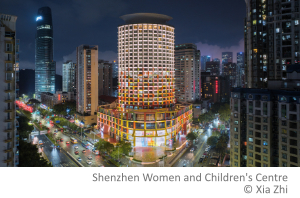 On Wednesday a new exhibition of MVRDV’s work, ReviveR, opened at the Shenzhen Women & Children’s Centre, the recently transformed tower building in Shenzhen’s Futian district. The exhibition offers an exploration of various narratives surrounding the building that hosts it, from the importance of playful, social, fun environments for people of all ages to the need to reuse outdated buildings and materials to reduce carbon emissions, following the principles of circularity. The exhibition – which is designed to be enjoyable and educational for adults and children alike – is on display in the building’s 5th floor auditorium until February 28th, 2024.
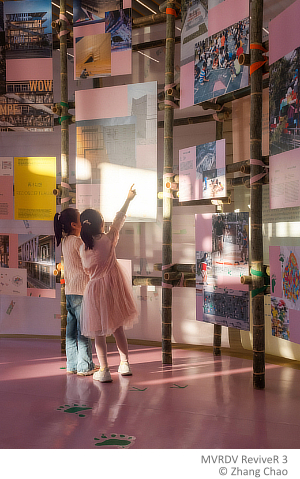 Completed in June, the Shenzhen Women & Children’s Centre is an emblematic project for the city of Shenzhen. Originally built in 1994 as part of the city’s explosive growth, the building was beset by problems caused by its rushed design and construction. The decision to renovate the structure, rather than demolish and replace it, allowed MVRDV to save 24,000 cubic metres of concrete from the original structure, resulting in a dramatic saving in carbon emissions. A grid of aluminium frames on the exterior have increased the energy performance of the façade, while the bright new colour palette communicates the building’s main purpose of providing facilities for the welfare of women and children. Selected as one of 24 model examples of revitalisation by China’s National Development and Reform Commission, the building sets a precedent in a city that will soon see a huge wave of similar buildings reach the end of their initial lifespan.
The ReviveR exhibition positions the Shenzhen Women & Children’s Centre as a kind of manifesto, asking “what would our cities look like if we pursued similarly playful, social, and sustainable transformations of all existing buildings?” The exhibition examines 27 key MVRDV designs through three lenses: projects that transform existing buildings; projects that exemplify MVRDV’s bold and playful style; and projects in the Southeast Asia region. At the centre of the space are seven “core projects” that are representative of all three categories simultaneously, including the Shenzhen Women & Children’s Centre itself.
The exhibition design similarly takes its cues from the Shenzhen Women & Children’s Centre. The most immediately noticeable example of this is in its colours, which replicate the yellow, green, orange, and pink of the building’s façade. On a deeper level, circularity – both figurative and literal – is a recurring theme. The curves and circles that characterise the building’s floorplans re-emerge in the layout of the exhibition, turning the three project categories into a Venn diagram with the core projects at the centre. Most of the materials used in the exhibition’s construction are locally sourced and reusable, with the exhibits mounted on bamboo structures, for example.
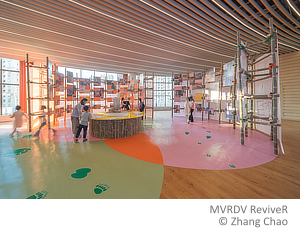 In the circular economy, every end is also a beginning; this is metaphorically reflected in the fact the exhibition can be experienced equally well in two directions – a tactic partly devised as a response to the auditorium space that hosts the exhibition, with entrances on both sides of the room. The exhibition’s palindromic name and the curatorial statement, which can be read with its paragraphs reversed, also reflect this “circular” characteristic.
The exhibition design takes a number of steps to ensure that even the youngest visitors to the Shenzhen Women & Children’s Centre can enjoy themselves. Alongside the exhibited projects are two worktables for children to practice the tools of the architect. On one, children will be invited to draw their city of the future, with the resulting drawings exhibited on the adjacent wall. On the other table, building blocks will allow the children to test their modelling skills and collectively build their city of the future. Animal tracks are used to guide children around the exhibition, with the bio-regions that the animals are endemic to referencing the locations of the projects; the exhibition brochure offers a guide to which animal makes which tracks alongside colouring games, and instructions to turn the brochure into an origami fan. Finally, while exhibitions are typically designed around visitors with an “eye-level” at around 1.7 metres high, ReviveR is designed with a second eye-level of around 1 metre, more suitable to children, in mind.
“It is poetic, in a sense, that we are able to put on this exhibition not only for designers, not even just for adults, but also for the children that visit this building”, says MVRDV founding partner Jacob van Rijs. “The projects that we present in ReviveR aim to ensure a better future for the world, and imagine what that future could look like. One day, the children that visit here will be the custodians of that future. They will, I hope, push the ideas we have started to explore to levels that we can’t even imagine today. If we play even the smallest role in inspiring them, we have succeeded.” |
|
|
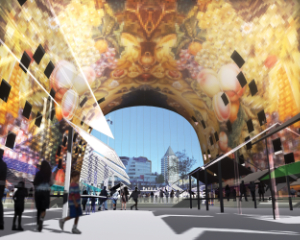
MVRDVHNI: The Living Archive of a Studio, Rotterdam (Netherlands), Het Nieuwe Instituut, 6 / 28 november 2021
The exhibition MVRDVHNI: The Living Archive of a Studio looks back to the roots of MVRDV’s design philosophy. Centred upon three themes – “human”, “green” and “dream” – the exhibition traces the connections between the firm’s early projects and their more recent designs, taking visitors on a virtual journey through thirty years of work. The exhibition will be held on the sixth floor of HNI, overlooking one of the firm's much- discussed recent designs, the Depot Boijmans Van Beuningen.
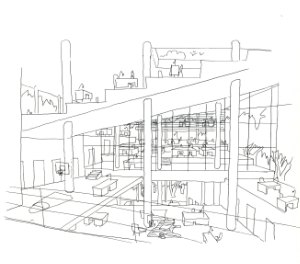 The first thing that springs to mind when you think of an architectural firm's archive is a scale model, but MVRDVHNI: The Living Archive of a Studio contains much more, from sketches to correspondence with engineers and contractors about the execution of designs. MVRDV, founded in 1993, was among the first generation of firms to create a mostly digital archive; it is the first digital archive of this size acquired by Het Nieuwe Instituut. This acquisition began in 2015, and with 1,200 projects now in MVRDV’s portfolio, the archive will only grow. The first thing that springs to mind when you think of an architectural firm's archive is a scale model, but MVRDVHNI: The Living Archive of a Studio contains much more, from sketches to correspondence with engineers and contractors about the execution of designs. MVRDV, founded in 1993, was among the first generation of firms to create a mostly digital archive; it is the first digital archive of this size acquired by Het Nieuwe Instituut. This acquisition began in 2015, and with 1,200 projects now in MVRDV’s portfolio, the archive will only grow.
The Living Archive of a Studio is an exhibition that is as incisive for an audience of architects as it is approachable for non-architects, inviting visitors to actively engage in the agency's exciting early days. This can be done by walking past the tables with explanations and models or by making a journey through the digital archive with Projectscape, a digital tool developed especially for this purpose by the MVRDV NEXT studio. HNI curators reflect upon the projects to add new layers to the story, and explore the possibilities of further opening up the archive by looking for cross-references. MVRDV-founders Winy Maas, Jacob van Rijs and Nathalie de Vries use archive documents to recall projects in which they were closely involved.
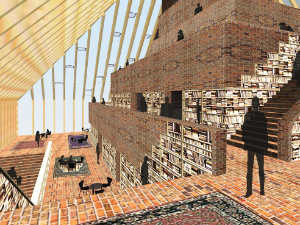 “This exhibition will shed light on the dynamic workings of one of the most innovative architecture studios today, and how a dialogue between the firm, its archive, researchers, and others can further enrich our understanding of the possibilities of architectural practice”, says Aric Chen, the General and Artistic Director of Het Nieuwe Instituut. “With this exhibition we want to show how the first 400 projects we did influenced later work”, says MVRDV partner Jan Knikker. “We think it’s important that our archive is accessible to everyone. Sharing knowledge makes our profession richer, which is why it was good for the HNI curators to regularly work in our offices during the preparation period. I also think that this exhibition will provide depth to people who will soon visit the Depot Boijmans Van Beuningen that we designed. It’s not a coincidence that the exhibition opens on the same day as the Depot.” “This exhibition will shed light on the dynamic workings of one of the most innovative architecture studios today, and how a dialogue between the firm, its archive, researchers, and others can further enrich our understanding of the possibilities of architectural practice”, says Aric Chen, the General and Artistic Director of Het Nieuwe Instituut. “With this exhibition we want to show how the first 400 projects we did influenced later work”, says MVRDV partner Jan Knikker. “We think it’s important that our archive is accessible to everyone. Sharing knowledge makes our profession richer, which is why it was good for the HNI curators to regularly work in our offices during the preparation period. I also think that this exhibition will provide depth to people who will soon visit the Depot Boijmans Van Beuningen that we designed. It’s not a coincidence that the exhibition opens on the same day as the Depot.”
The Living Archive of a Studio will be furnished with used furniture and, after the exhibition, it will generate minimal waste because all the material will be reused. This approach suits MVRDV, which has been concerned with sustainability since its inception. Having grown up with the warnings of the Club of Rome, the office wants to contribute to global measures to combat climate change – from the densification of cities and working towards CO2-neutral construction to the development of future visions of green cities in collaboration with think tank The Why Factory. |
|
|
| MVRDV Haus Berlin / MVRDV House Berlin, Berlin, Architektur Galerie Berlin, 10 july / 22 august 2020
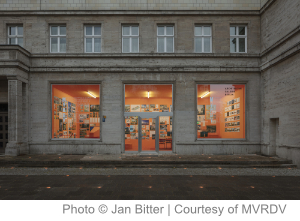 MVRDV celebrates opening of its Berlin office with MVRDV Haus Berlin exhibition MVRDV celebrates opening of its Berlin office with MVRDV Haus Berlin exhibition
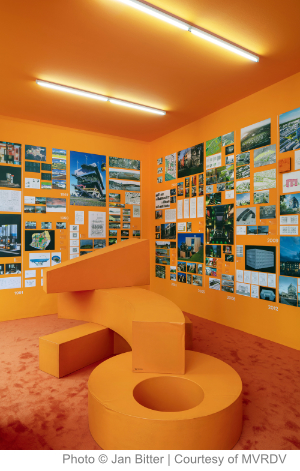
Ahead of the opening of their new Berlin office in September, MVRDV has launched a new exhibition at the Architektur Galerie Berlin, celebrating almost 30 years’ worth of work in Germany. The walls of MVRDV Haus Berlin form a densely packed archive that shows off both current and past German projects by MVRDV – including unseen projects from our past and newly-revealed future projects. At the same time, a team of MVRDV’s architects working on German projects transforms part of the exhibition into a ‘working office’ that gives visitors an insight into MVRDV’s working methods.
MVRDV’s relationship with Germany began in their very first project, the Europan 1991 winner Berlin Voids. The project encapsulates ideas that have come to define MVRDV’s work as a practice, and soon the bold designs of the newly founded MVRDV office were implemented in Germany: The equally radical and impressive proposal for the Dutch pavilion at Expo 2000 became an icon on the Expo site in Hannover.
But there is much more architecture by MVRDV in Germany, some only on paper but much of it realized. For example, the Unterföhring Park Village was completed shortly after Expo 2000, while Werk12 in Munich was completed in 2019. Other projects are currently under construction such as Phase 2 of Hamburg Innovation Port and Zollhafen Mainz, and more designs are in progress, such as the KoolKiel development, Kreativquartier Potsdam, and the recently announced Expo Pavilion 2.0, including renovations and additions to the original Expo 2000 building.
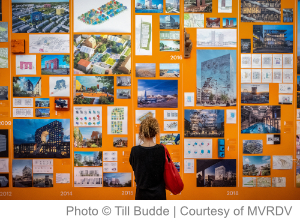 MVRDV Haus Berlin replicates the spirit of the firm’s headquarters in Rotterdam, not only in appearance with signature wall-to-wall orange monochrome, but also in its transparency. Visitors are invited to enter a working office, gaining insight into not only MVRDV’s projects but also the way MVRDV works. MVRDV Haus Berlin replicates the spirit of the firm’s headquarters in Rotterdam, not only in appearance with signature wall-to-wall orange monochrome, but also in its transparency. Visitors are invited to enter a working office, gaining insight into not only MVRDV’s projects but also the way MVRDV works.
“When we competed in Europan, whether or not the project would be built was not our main priority – being radical was”, says founding partner Jacob Van Rijs. “Now that we’ve had a chance to work more in Germany and even built some of our designs, we look forward to bringing that radical streak to Berlin on a permanent basis. We hope that sharing our work and working methods in MVRDV Haus Berlin will form the start of a productive exchange of ideas between MVRDV and other German architects, clients, officials, and the public.”
MVRDV Haus Berlin is open at the Architektur Galerie Berlin through August 22nd. The firm’s new permanent office near Park am Gleisdreieck will open in September. |
|
|
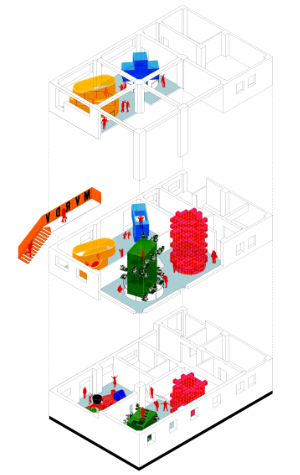 Architecture Speaks: The Language of MVRDV Architecture Speaks: The Language of MVRDV, Innsbruck (Austria), Adambräu, 6 july / 28 september 2019
On July 5th, the Tyrolean Architecture Center (aut) in Innsbruck will open “Architecture Speaks: The Language of MVRDV”, a major exhibition on the role of language in defining recurring concepts in the oeuvre of the Dutch firm. The aut’s Adambräu Building, a former brewhouse, will be filled by a spatial intervention comprising four towers that serve as distillations of four concepts key to MVRDV’s designs. The exhibition, which investigates the creation and evolution of these four ideas and the words that describe them, is structured around the spatial intervention, creating an immersive experience that helps visitors easily grasp the fundamentals of the MVRDV thought process.
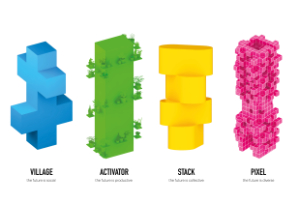 The words studied in Architecture Speaks are “stack”, “pixel”, “village”, and “activator”. “Stack” denotes a layering of functions and spaces perfectly encapsulated by projects such as the Silodam; “pixel” is applied to a spatial module that can be combined with other pixels to introduce diversity, exemplified by projects such as DNB Oslo Headquarters; “village” describes a spatial arrangement that encourages community and social intimacy, as in projects such as Nieuw Leyden; and “activator” refers to elements that create productive social spaces, such as the Stairs to Kriterion. All four words were selected due to their roles in encouraging healthy and prosperous densification, reflecting MVRDV’s mission to accommodate an ever-growing human population in spaces that encourage society to flourish. The words studied in Architecture Speaks are “stack”, “pixel”, “village”, and “activator”. “Stack” denotes a layering of functions and spaces perfectly encapsulated by projects such as the Silodam; “pixel” is applied to a spatial module that can be combined with other pixels to introduce diversity, exemplified by projects such as DNB Oslo Headquarters; “village” describes a spatial arrangement that encourages community and social intimacy, as in projects such as Nieuw Leyden; and “activator” refers to elements that create productive social spaces, such as the Stairs to Kriterion. All four words were selected due to their roles in encouraging healthy and prosperous densification, reflecting MVRDV’s mission to accommodate an ever-growing human population in spaces that encourage society to flourish.
“Exhibitions such as this one at the aut are always a valuable tool to share our design approach with the world,” says MVRDV founding partner Nathalie de Vries. “But even more importantly, the creation and curation of Architecture Speaks was an opportunity for us to reflect on our work, to define theoretical categories and place projects from our firm’s recent trajectory into a larger framework of ideas.”
Architecture Speaks will investigate these ideas in a holistic, easily approachable fashion. The main space of the Adambräu Building will be transformed by four colourful towers, each a representation of one of the four words central to the exhibition, which will present MVRDV’s projects and the ideas behind them through images, text, models, drawings, videos, audio, interactive elements, and other experiential methods. In addition to each representing a different word from the language of MVRDV, each tower will present MVRDV buildings through different media, making a visit to Architecture Speaks a truly diverse experience that will enlighten and entertain a variety of audiences.
The exhibition on the work of MVRDV is the latest in a series of notable architecture shows at the aut, following Inhabiting: Pleasure and Luxury for Everyone in 2018 on the work of Lacaton & Vassal, and Snøhetta: Relations in 2017. Architecture Speaks: The Language of MVRDV is on display to the public from July 6th to September 28th at the aut’s Adambräu Building on Lois Welzenbacher Platz in Innsbruck, Austria. The aut is free to enter and is open from 11am to 6pm Tuesday – Friday, and until 5pm on Saturday. |
|
|
| 20 years of MVRDV. An Exhibition, Bangalore (India), InCITE Gallery, 24 november / 7 december 2012 |
|
|
MVRDV, The Why Factory, The Vertical Village
Taipei (Taiwan), Chung Shan Creative Hub, 8 october 2011 / 8 january 2012
Seoul, Total Museum of Contemporary Art Seoul, 20 june / 7 october 2012
Hamburg, Hamburg Museum, 2 august / 29 september 2013 |
|
|
 20 MVRDV, Hamburg, USM, 11 may / 11 june 2012 20 MVRDV, Hamburg, USM, 11 may / 11 june 2012 |
|
|
| 3D City: Studies in Density, Ann Arbor (MI), Taubman College Gallery, room 2106, 4 november/12 december 2008 |
|
|
| MVRDV H20. Water City Projects, Berlin, Aedes am Pfefferberg, 13 june/27 july 2008 |
|
|
| The Hungry Box. The endless interiors of MVRDV, Athína (Athens), Benaki Museum, 25 may/29 september 2007 |
|
 |
 |
 |
 |
ADDITIONS AND DIGRESSIONS |
 |
|
|
 |
|
 |
 |
 |
| |
 |
|
#DGEVOLUTION, Milano, Palazzo Labus, 4 / 9 April 2017
MVRDV takes part in the exhibition to launch #DGEVOLUTION featuring six international architecture firms chosen to create a new conceptual vision for future Dolce&Gabbana boutiques.
Dolce&Gabbana ushers in a new era for its luxury retail boutiques by handing over creative freedom to six international architecture firms, who will transform individual stores in Milan, Porto Cervo, Capri, Tokyo, St. Barth, London, Brussels, Monte Carlo, Venice, Beijing, Los Angeles and Dubai, whilst responding to both context and the brand's history.
MVRDV is set to design a new flagship location in line with this new approach. A one of a kind, location specific design in collaboration with the brand to bring a unique interpretation of the Dolce & Gabbana story for contemporary buyers. This heralds a more emotive, diverse and cultural influence on their boutiques making them experiential, and a move away from the now dated concept store model. The designers of the fashion house have initiated a dialogue with the chosen architects to create radical and unusual perspectives for the brand and their locations, making them one-of-a-kind. |
|
 |
 |
 |
 |
  |
 |
|
|